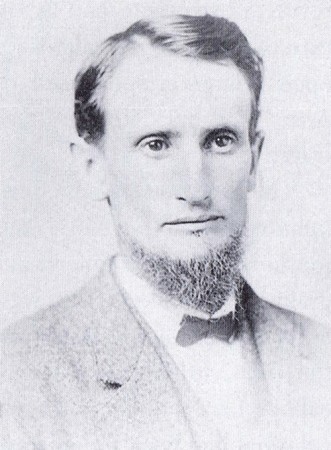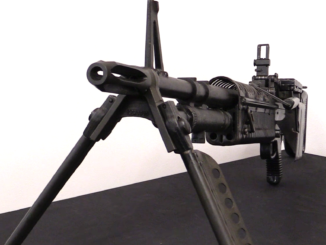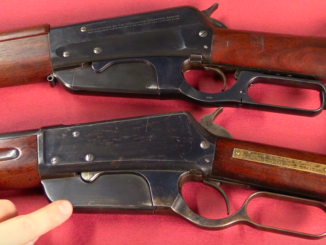“[A] quiet little Yankee who sold himself in relentless slavery to his idea for six weary years until it was perfect” – John Hay, secretary to Abraham Lincoln

Christopher Spencer was born on a farm in Manchester, Connecticut on June 20th, 1833, the son of Ogden Spencer and Asenath Hollister. At the age of 12 (in 1845), young Christopher moved into the home of his maternal grandfather Josiah Hollister, than 90 years of age. Josiah was a veteran of the American Revolution and a gunsmith, and he nurtured and encourages Christopher’s interest in firearms and machinery. One of his favorite pastimes was working with his grandfather’s old foot lathe, making intricate knick-knacks of wood. His grandfather also gave him his first firearm, a Revolutionary-era musket. In a classic example of the American spirit of tinkering, he immediately sporterized it, sawing off the barrel to make it handier for hunting (yes I can hear all the collector’s cringing at the thought – but wouldn’t you like to have it today anyway?).
At the age of 14 (in 1847) Spencer left home to work as an apprentice in a local silk mill owned by two brothers, Charles and Rush Cheney – who would be close partners with him for many years to come. This initial employment lasted barely a year, and in 1848 Spencer took on a more advanced apprenticeship with machinist Samuel Loomis in Manchester Center, CT. It seems quite likely that this apprenticeship was taken with the blessing of the Cheneys, for at its conclusion he returned to work in their silk mill. It is also worth noting that the winter of 1848 was the only time Spencer spent in school – 12 weeks in the Wilbraham Academy in Massachusetts.
With the experience of his work for the Cheneys and his machinist’s apprenticeship, Spencer’s mechanical genius really showed itself. His real passion, I suspect, was machines to make things – not necessarily the final product itself. Working for several years in the Cheneys’ silk mill, he developed several new machines, as well as showing a real talent for repairing and maintaining machinery. He did wander out form under the Cheneys’ wing to expand his understanding with stints working in other shops, including the New York Central Railroad locomotive repair shop, the Ames Manufacturing Company (a sword and cutlery maker) and a year working for Colt in Hartford.
Returning home from Colt with some newly-planted ideas for improved firearms designs, Spencer went back to work for the Cheneys, this time as superintendent of their new shop in Hartford. He was clearly quite at home in this environment, as he spent 11-hour days in his formal job (including inventing and patenting silk winding machine which they Cheneys sold quite a few of, and paid him a royalty on), and then spent his spare time tinkering in the shop with his ideas for a repeating firearms which would eventually become the 1860 Spencer rifle. He made a wooden mockup of the gun in 1857 (sadly, this first model appears to be lost to time). Spencer’s father Ogden financed the initial prototype (which ended up costing $293.67 to make) in exchange for a 50% share of future profits, and when the Civil War broke out the Cheney brothers became very interested in producing the gun for military contracts. They bought the patent from Spencer for $5000 and a royalty of $1 per gun sold.

Spencer spent the next several years working on the improvement, production, and marketing of his rifle (including a personal shooting demonstration with then-President Abraham Lincoln). The design was a good one and well-suited to the desires of the US military at the time, but by the late 1860s it was clear that the Spencer could not keep us with newer and better guns like the Winchester 1866, which allowed significantly faster shooting and reloading. In 1868 the Spencer rifle company was near bankruptcy, and was purchased by the Fogarty Repeating Rifle Company, not so much for the Spencer rifle but instead for the company’s machinery. Fogarty’s venture flopped, and in April 1869 its assets were all bought up by Winchester, including (ironically) several thousand unsold Spencer rifles and carbines. Right at this time the French government was desperately looking for arms after their disaster at Sedan, and Winchester promptly sold them every last Spencer it had in the warehouse (among other guns).
Spencer had not been a partner in the company (being paid royalty instead), and bounced right back from its failure. In 1866 he began a new venture with Sylvester Roper to make revolving-magazine shotguns. The guns proved too expensive to be a commercial success, and the company and its assets became Billings & Spencer by 1872, engaged in making commercial forgings and sewing machine parts. Spencer continued to indulge his mechanical interests, with an 1872 patent for a new single-shot rifle and work in the 1880s with Roper (again) on a pump action shotgun.
Ultimately, his fortune was secured by the invention of an automated screw-making machine – a device which also guaranteed his name a place in the history of industrial development. With age and wealth he finally relaxed a bit, spending time with his wife and children and continuing to tinker. He built a steam-powdered automobile in 1901, and was dabbling with aeronautics when he died at his home in Windsor Connecticut on January 14, 1922.
Christopher Spencer was one of the stereotypical 19th century American inventors who had no need of formal education and simply believed that an individual’s drive to invent and experiment could bring about wondrous new possibilities. He was always in the shop getting his hands dirty, and it made him a wealthy man.
Bibliography:
Case, Lafayette Wallace M.D. The Hollister Family of American. Hartford, Connecticut, 1886.
Bilby, Joseph G. A Revolution in Arms. Westholme Publishing; Yardley, Pennsylvania, 2006.




Bilby’s two books have come here, and since A Revolution in Arms was a known quantity thanks to your review, I started with his book on the Small Arms of Gettysburg. I thought I knew it all, and couldn’t imagine how dull a book on the North’s Springfields and the South’s Enfields could be. Instead, it’s really been an education. I didn’t know —
– the north too imported guns, not just Enfields (in massive quantities) but Austrian Lorenz rifles, for instance.
– many smoothbores were still in service. Some regiments and some generals preferred them!
– the smoothbores were mostly loaded with “buck and ball,” and were about as lethal as rifles at the same ranges.
– there were several projectiles used besides the old round ball and the newer Minié.
– some units practiced their marksmanship, some didn’t.
– there were snipers but they were vulnerable to being overrun by line infantry, and some were.
– after the battle, tens of thousands of rifles were cleared off the battlefield but only a fifth that number of bayonets.
Bilby’s good. He can write technical stuff without it being too dry. Conversely, I’m working my way through a book on greek hoplite warfare based on a guy’s dissertation, and it’s drier than the Sahara sand even though it’s radical new thinking that overturns centuries of scholarship. But the guy’s writing is leaden even when his ideas are solid gold.
That became really clear when compared to Bilby’s lively writing.
The book “Spencer Repeating Firearms” by Roy M. Marcot is,IMO, a good book about both the man and the firearms he designed.
Billings and Spencer was a major subcontractor in the Connecticut valley gun trade. A.C.Gould in his book The Modern American rifle lists many of the forgings that Billings and Spencer made for such companies as Marlin. So Spencer’s connection to the firearms industry is greater than first realized.
The Spencer-Roper shotgun is an interesting piece, here’s a video from the NRA museum showing the basic functioning.
I guess that qualifies as an open bolt single action shotgun? Not a common combination of characteristics.
Many thanks for the link to the vid.
It is very interesting (and useful) to see the Roper’s cylinder shrouding.
I wonder whether it was ever recognized as prior art for this application http://worldwide.espacenet.com/publicationDetails/originalDocument?CC=US&NR=2002166277A1&KC=A1&FT=D&ND=3&date=20021114&DB=EPODOC&locale=en_EP
(by the company who hates us because we suck…)
Looking more closely, that application has been allowed to lapse, which leaves the way open for someone to put cylinder shrouding, and a more compact (?semmerling type) striker on one of these
http://worldwide.espacenet.com/publicationDetails/originalDocument?CC=US&NR=1067004A&KC=A&FT=D&ND=3&date=19130708&DB=EPODOC&locale=en_EP
and to chamber it in .38spcl
“the north too imported guns, not just Enfields (in massive quantities) but Austrian Lorenz rifles, for instance”.
The North was also trying to use its economic power to tie up all of Europe’s industrial output so that the South had no where to buy munitions.
One of histories first examples of total warfare in action.
Dean
According to Bilby, the reason for importation was a little more direct and prosaic: as frantically as the Union was grinding out 1858 Springfields, they couldn’t arm all the new regiments with them, let alone replace battlefield losses, and they needed something; European imports would do.
Of course, having a substantial Navy, the Union was able to blockade the South, while its own imports shipped without harassment. I wonder if some of the Union Enfields were actually seized from captured would-be blockade runners?
The South also had to export its products (principally cotton and textiles, and other agricultural products). So the blockade runners were laden on both legs of their voyages.
It would be interesting to dig into the logistics and see what people have written about Union purchasing in Europe. Civil War scholarship is a bit daunting because there’s so very much of it. I have been much more interested in the Revolutionary War, and 20th and 21st century insurgencies, than in this great American war, so my knowledge of it is very shallow indeed.
Thinking of it another way, I’m not sure the North could have tied up “all Europe’s output” even of a narrow market sector like small arms. Supply increases to sate demand, the whole thing mediated by price signals. If the North and South got in a bidding war for a million stand of arms, the factories of Europe would retool to make another million forthwith. This was probably understood well enough in 1860 (Bastiat was writing then).
Anyway, I do strongly recommend both Bilby books (A Revolution in Arms, about repeaters, and Small Arms of Gettysburg. I’ve found it handy to have my West Point Atlas open to Gettysburg as I read along, as he assumes everyone knows the who-shot-John of this complicated, multiday battle as well as he does.
Many of the European manufactures came the to North attempting to sell gun. What they found was that the US factories were greatly more modern and had much greater output than the European factories. Wendel, for example, ended up buying new equipment here to retool and modernize his factory in Austria. Europe was in no position to supply very many guns to either side. Nor would have they been able to retool their factories.
Also, keep in mind that the North produces around 750,000 various breech loaders during the war. That would have been enough, in theory to completely equip the Union’s front line troops with them.
This story is a classical example illustrating how the North-Eastern United States ( particularly New York and Southern New England ) as well as parts of the near Mid-West ( such as the state of Ohio ) was the primary engine driving the American Industrial Age. Innovation, invention and manufacturing technology were the order of the day, and it gave rise to some of the best-known names in every category of inmdustry, firearms included. It was the golden age of the industrial barons, the so-called “Captains Of Industry”.
Although I am basically native to Florida, there was a period of time in the mid- to late 1990’s when I lived in Windsor, CT due to work commitments and visited Manchester, CT quite often as I had friends there. This period of time also enabled me to see the old Colt Firearms manufactory in Hartford, CT, which had long since been vacant and was the subject at the time of conversion into a remediated brownfields residential apartment building, as well as the old industrial districts in places such as Binghampton / NY, Bridgeport / CT and Bath / ME. Although much of the original infrastructure in places like these is gone, enough remains to enable the observer to get a feel for the enormous scale of that infrastructure when it was at its peak.
Sorry for the typographical error, guys — the beginning of Line 5, Paragraph 1 should read “industry”.
I would like more infromation on the Spencer family. Can you help me? I am married to the granddaughter of PH Spencer. Thank you, John Johnson
Sorry John – I don’t have any more information than I was able to find in the Spencer firearms book.
my maiden name is Spencer. I am interested in my family tree. Could there be a connection? Just interested.
Am the grandaughter of C.M.Spencer. .P.H.Spencebeing my grandfather,u did get the pleasure to know,spend time with. . Attending air-shows,when we could ,watching him in his element. . He was so passionate about flying. . Am just now starting to read and discover in depth the civil war,the tremendous contributions C.M.made. . I want my 2 sons to have a fresh take on there roots. .